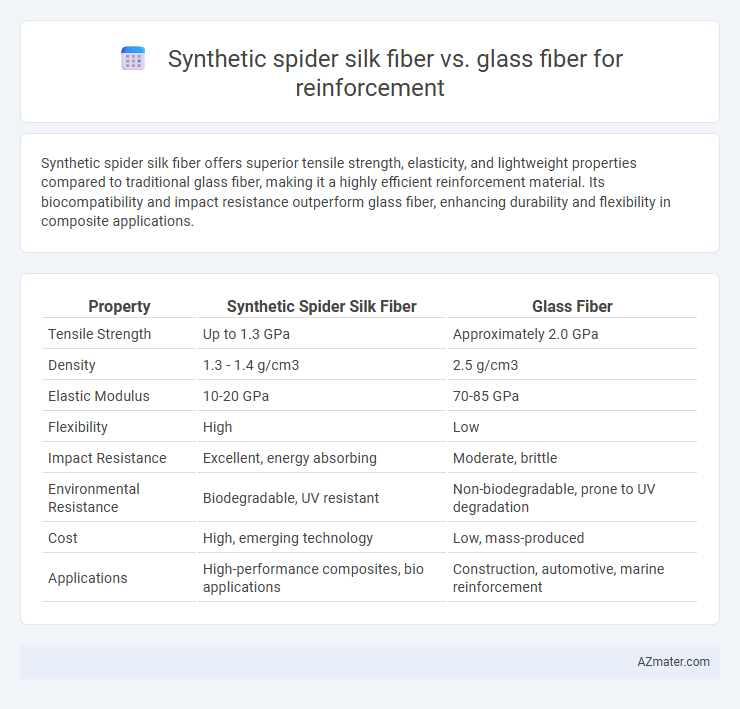Synthetic spider silk fiber offers superior tensile strength, elasticity, and lightweight properties compared to traditional glass fiber, making it a highly efficient reinforcement material. Its biocompatibility and impact resistance outperform glass fiber, enhancing durability and flexibility in composite applications.
Table of Comparison
| Property | Synthetic Spider Silk Fiber | Glass Fiber |
|---|---|---|
| Tensile Strength | Up to 1.3 GPa | Approximately 2.0 GPa |
| Density | 1.3 - 1.4 g/cm3 | 2.5 g/cm3 |
| Elastic Modulus | 10-20 GPa | 70-85 GPa |
| Flexibility | High | Low |
| Impact Resistance | Excellent, energy absorbing | Moderate, brittle |
| Environmental Resistance | Biodegradable, UV resistant | Non-biodegradable, prone to UV degradation |
| Cost | High, emerging technology | Low, mass-produced |
| Applications | High-performance composites, bio applications | Construction, automotive, marine reinforcement |
Introduction to Reinforcement Materials
Synthetic spider silk fiber offers exceptional tensile strength and elasticity, closely mimicking natural spider silk, making it a promising reinforcement material in composites. Glass fiber, widely used in reinforcement, provides high stiffness and good cost-efficiency but is relatively brittle compared to synthetic spider silk. Both materials enhance the mechanical properties of composites, with synthetic spider silk fibers showing potential for lightweight and high-performance applications due to their superior toughness and biocompatibility.
Overview of Synthetic Spider Silk Fiber
Synthetic spider silk fiber offers exceptional tensile strength and elasticity, closely mimicking the natural properties of spider silk, making it a promising alternative for reinforcement applications. This bioengineered fiber exhibits high toughness, biodegradability, and lightweight characteristics compared to conventional glass fiber, which is rigid and heavier. Its superior fatigue resistance and environmental sustainability position synthetic spider silk as a cutting-edge material in advanced composite manufacturing.
Properties of Glass Fiber
Glass fiber exhibits high tensile strength, excellent chemical resistance, and superior thermal stability, making it a durable choice for reinforcement applications. Its stiffness and lightweight nature contribute to enhanced structural integrity without significantly increasing weight. Compared to synthetic spider silk fiber, glass fiber provides consistent mechanical performance and greater resistance to environmental degradation.
Mechanical Strength Comparison
Synthetic spider silk fiber exhibits exceptional tensile strength ranging from 1.1 to 1.5 GPa, surpassing many traditional reinforcement materials including glass fiber, which typically ranges between 2.0 to 3.5 GPa but suffers from brittleness and lower extensibility. Unlike glass fiber's modulus of elasticity around 70 GPa, synthetic spider silk offers superior toughness due to its high elongation at break, making it ideal for applications requiring both strength and flexibility. The combination of high tensile strength and remarkable strain capacity positions synthetic spider silk as a promising alternative to glass fiber in advanced composite reinforcement.
Toughness and Flexibility Analysis
Synthetic spider silk fiber exhibits superior toughness compared to glass fiber, owing to its remarkable energy absorption capacity before failure, making it highly resistant to fracture. The flexibility of synthetic spider silk surpasses that of glass fiber, allowing it to endure significant deformation without breaking, which is critical for dynamic load applications. These mechanical properties position synthetic spider silk as a promising reinforcement material in composites requiring enhanced toughness and flexibility over traditional glass fiber reinforcements.
Environmental Impact and Sustainability
Synthetic spider silk fiber demonstrates superior environmental benefits over glass fiber due to its biocompatibility, renewable production from engineered microbes, and lower energy consumption during manufacturing. Glass fiber manufacturing involves energy-intensive melting processes and generates non-biodegradable waste, posing long-term ecological challenges. The biodegradable nature of synthetic spider silk reduces landfill burden and aligns with sustainable material innovation in composite reinforcement applications.
Cost and Production Scalability
Synthetic spider silk fiber offers superior tensile strength and elasticity compared to glass fiber, but its production cost remains significantly higher due to complex bioengineering processes. Glass fiber benefits from established mass-production techniques, enabling cost-effective scalability with well-developed global manufacturing infrastructure. Despite higher expenses, synthetic spider silk shows potential for niche applications where performance justifies investment, but widespread adoption depends on breakthroughs in cost-efficient, large-scale synthesis methods.
Applications in Structural Reinforcement
Synthetic spider silk fiber exhibits exceptional tensile strength and flexibility, making it an ideal material for structural reinforcement in lightweight and high-performance applications such as aerospace and sports equipment. Its biodegradability and superior impact resistance offer sustainable advantages over traditional glass fiber, which is widely used for its cost-effectiveness and high stiffness in construction and automotive sectors. The combination of synthetic spider silk's toughness and glass fiber's rigidity enables optimized composite materials tailored for enhanced durability and load-bearing capacity in advanced structural systems.
Future Prospects and Innovations
Synthetic spider silk fiber offers exceptional tensile strength, elasticity, and biodegradability compared to traditional glass fiber, positioning it as a revolutionary material for future reinforcement applications. Innovations in bioengineering and molecular synthesis are advancing scalable production methods, enabling synthetic spider silk to rival glass fiber in cost and performance. The integration of synthetic spider silk in composite materials promises enhanced durability, lightweight structures, and environmental sustainability, driving its adoption across aerospace, automotive, and construction industries.
Conclusion: Choosing the Optimal Fiber
Synthetic spider silk fiber offers superior tensile strength, elasticity, and biodegradability compared to glass fiber, making it an ideal reinforcement for lightweight, durable, and environmentally friendly composites. Glass fiber remains cost-effective and widely available, providing excellent rigidity and thermal resistance suitable for heavy-duty and industrial applications. Selecting the optimal fiber depends on balancing performance requirements, environmental impact, and budget constraints for specific reinforcement needs.

Infographic: Synthetic spider silk fiber vs Glass fiber for Reinforcement
 azmater.com
azmater.com